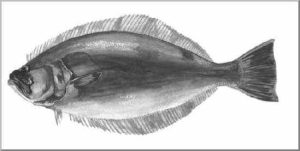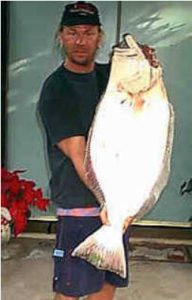All About Halibut
In these fish-specific pages, I’ll try to give you all sorts of insights into the specific fish we’re discussing to increase your chances of being successful in catching them.
Halibut

California Halibut (Paralichthys californicus) are the most famous of all sand flat fish. Everyone loves to catch and eat Halibut. This is not the species that grow to 300 lbs or more in Alaska (Pacific Halibut), but a home grown, Southern California only, species. They’re just as tasty as their bigger cousins, though. Halibut start out their lives swimming more or less like other fish, vertically in the water with one eye on each side of their heads. As they pass from this juvenile stage into adulthood, one eye migrates from its original position around the nose of the fish and ends up on the other side. The blind side then turns white and the fish begins swimming horizontally over the bottom with the white, blind side down. Halibut are members of the left-eyed flat fishes, however 40% of them are actually right eyed (the left eye migrates to the right side.)
California Halibut can grow to five feet long and 60 lbs, but most are far smaller. In fact, throughout most of the 1980’s and 1990’s it was very unusual to find a keeper sized Halibut (22 inches.) You would throw twenty back for every fish that measured up. Now, since conservation efforts and heavy restrictions on where trammel nets (the commercial nets used for flat fish) may be set, the population of Halibut is increasing and the sizes of sport caught Halibut is also increasing. By 1997, about half of all Halibut caught were breeding adults (bigger than 22 inches) so the comeback of this sought after game fish is well on its way.
Catching Halibut

Halibut are masters of ambush. They sit partially buried on the bottom awaiting prey to wander by, then leap out grabbing the unsuspecting forage fish. Halibut usually prefer live bait. Even scientists used to believe they were more like Sole or Sand Dabs grubbing for food and scavenging anything that came by, but now it’s known they’re aggressive predators. They eat sardines, anchovies, squid and any other smaller bait fish.
Halibut range from in-shore beaches, harbors and river mouths, all the way to deep, deep water. They live in over 1000 feet of water. Deep water caught fish are the best eating, but often trophy fish are caught in about 20 feet of water.
To catch Halibut, drift over likely sandy bottom with a live anchovy, sardine, herring or other bait fish (grunion work great too!) with a reverse dropper loop setup – that is, a sinker attached to a loop tied a foot or two above the bait. Keep it close to the bottom and just barely moving to cover more ground. Halibut wait for bait so if you keep your bait still, it might be literally inches from the tail of a big fish and it would never know it was there. Use just enough weight so that the bait stays on the bottom. When Halibut hit, they mouth the bait first so the strike is more like a slight ticking feel on the line. At this stage have patience, if you set the hook too soon, you’ll pull the bait right out of the Halibut’s mouth. Give it line and when you’re fairly sure it’s got the bait, go ahead and set the hook.
Halibut will also strike lures. Rubber swim baits seem to work best and are even more effective when baited with a thin strip of cut squid. Halibut have even been known to come up off the bottom and strike deep trolled salmon lures.
Preparing Halibut
On the boat, have Halibut headed and gutted, then ice them down quickly. The meat is delicate so spoils easily. Once home peel four nice fillets off the fish. Don’t bother trying to steak the fish, like Pacific Halibut in the grocery store, the local variety are usually too thin for this. Be sure to peel off the engawa (outer strip of meat at the base of the fins.) The Japanese know how to find these great eating morsels on different types of fish. It makes excellent sashimi!
Eating Halibut
Halibut are one of the best-eating fish in California waters and have the most broad appeal to people with different tastes. I’ve never heard anyone ever say that fresh Halibut tastes fishy. They’re excellent as sashimi, baked, broiled, fried, sauteed, and even poached. The meat is light, delicate, flavorful, and mild.


